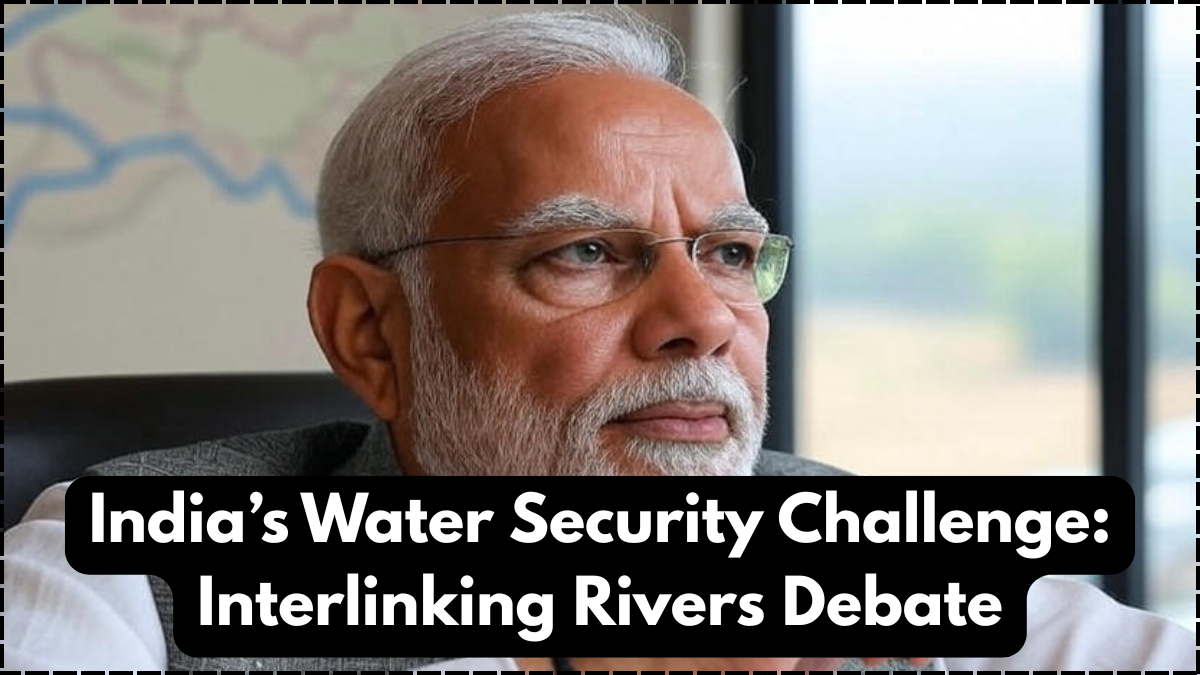Water security India is one of the most pressing challenges in the 21st century. With rising populations, climate change, and growing industrial demands, ensuring equitable and sustainable access to water has become a national priority. One of the most debated solutions to this challenge is river interlinking, a project aimed at transferring water from surplus regions to deficit areas. While this ambitious plan promises to address droughts and floods, it also raises serious environmental, social, and economic concerns.

The Current Water Security Challenges in India
India houses nearly 18% of the world’s population but has only 4% of its freshwater resources. This imbalance is the root of the water security India crisis. Rapid urbanization, over-extraction of groundwater, pollution of rivers, and irregular rainfall patterns due to climate change are worsening the issue. Millions of people face water scarcity during summers, while states often clash over shared river resources.
Key water security challenges include:
- Over-dependence on monsoons for agriculture
- Depleting groundwater reserves
- Inefficient irrigation practices
- Pollution in major rivers like the Ganga and Yamuna
- State-level disputes over water sharing
It is against this backdrop that river interlinking is being considered as a long-term solution.
Understanding River Interlinking
The concept of river interlinking involves building canals, dams, and reservoirs to connect rivers, allowing water transfer from surplus basins to drought-prone regions. The ambitious National River Linking Project (NRLP) aims to connect 37 rivers through 30 links across India.
Supporters argue that interlinking can:
- Provide irrigation to drought-hit regions
- Reduce floods in surplus river basins
- Improve inland navigation and hydropower generation
- Enhance water security India through better distribution
However, critics point to risks such as ecological damage, displacement of communities, and the enormous financial burden of the project.
Comparing Benefits and Risks of River Interlinking
A closer look at the benefits and risks of river interlinking helps assess whether this solution truly secures water security India:
| Aspect | Potential Benefits | Major Risks |
|---|---|---|
| Irrigation & Farming | Expanded irrigation for drought-prone areas | Loss of natural river flows and ecosystems |
| Flood Management | Flood control in surplus basins | Possible flooding in newly linked regions |
| Economy | Boost to agriculture and hydropower | High financial costs, long implementation |
| Environment | Better water access in dry regions | Biodiversity loss, deforestation, displacement |
| Interstate Relations | Reduced disputes in theory | May create new conflicts over shared canals |
This comparison shows that while river interlinking offers solutions, it also introduces new challenges.
Alternative Solutions to Water Security
Experts argue that water security India may be better achieved by adopting localized and sustainable measures alongside or instead of massive projects like river interlinking.
Some promising alternatives include:
- Rainwater harvesting: Capturing monsoon water for future use.
- Groundwater recharge: Restoring aquifers through natural and artificial means.
- Efficient irrigation: Using drip and sprinkler systems to save water.
- Wastewater recycling: Treating and reusing water for non-drinking purposes.
- River restoration: Reviving natural flows instead of altering them.
Such measures, combined with policy reforms and community participation, can make water security India more resilient and sustainable.
Conclusion
The interlinking of rivers represents both a promise and a peril in the quest for water security India. While it could provide relief to drought-hit regions and reduce floods, the ecological, financial, and social risks cannot be ignored. A balanced approach that blends river interlinking with localized water conservation methods is crucial for long-term sustainability. India must choose wisely between short-term fixes and long-term resilience in addressing its water challenges.
FAQs
What is river interlinking?
It is a large-scale project that connects rivers through canals and reservoirs to transfer water from surplus to deficit regions.
Why is water security India a concern?
India faces uneven water distribution, over-extraction of groundwater, and climate change-driven rainfall variability, making water security a critical issue.
What are the benefits of river interlinking?
It can provide irrigation, reduce floods, boost hydropower, and improve water access in drought-prone regions.
What are the risks of river interlinking?
Risks include environmental damage, high costs, displacement of people, and possible new water-sharing disputes.
What are alternatives to river interlinking?
Rainwater harvesting, groundwater recharge, efficient irrigation, wastewater recycling, and river restoration are effective alternatives.
Click here to learn more